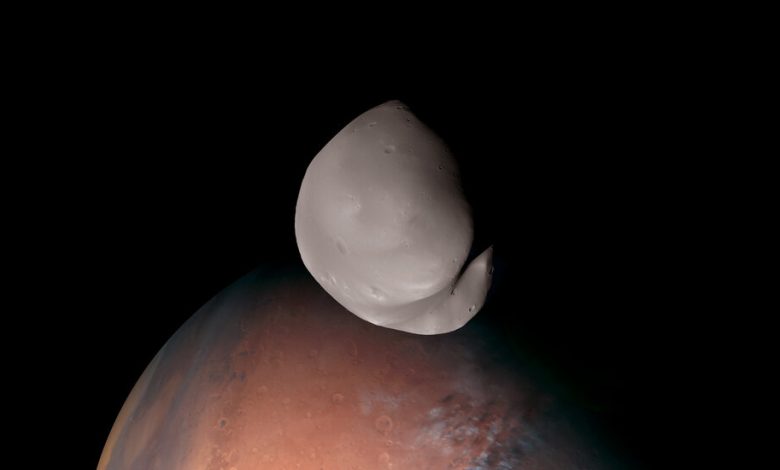The Smallest Moon of Mars May Not Be What It Seemed

Deimos, the smaller of the two moons of Mars, might be a chip off the old block — quite literally.
That’s the conclusion drawn by scientists in the United Arab Emirates, whose Hope orbiter — also called the Emirates Mars Mission and the country’s first interplanetary spacecraft — just snapped the best views of Deimos ever taken by human spacecraft.
“We’re getting the highest resolution ever,” said Hessa Al Matroushi, the science lead on the mission at the Mohammed Bin Rashid Space Center in Dubai.
Mars has two irregularly shaped moons, and neither is mighty. Phobos, the larger of the two, is about 17 miles in diameter at its widest, and orbits closer to the red planet at an altitude of about 3,700 miles. Deimos is just nine miles across on its longest side, and completes an orbit of Mars every 30 hours at an altitude of 15,000 miles.
The moons’ small size and quirky dimensions led to suggestions that they may be asteroids captured by Mars long ago. Not so, say researchers analyzing data recorded by Hope, which entered orbit around Mars in February 2021.
The mission, primarily intended to study the Martian atmosphere, has spent 2023 in an extended phase performing multiple flybys of Deimos. Hope got as close as 60 miles above the mini-moon’s surface in March, a distance beaten only by NASA’s Viking 2 orbiter in 1977, which reached about 19 miles above the surface but with more primitive instruments and cameras.
Hope’s three scientific instruments were able to probe the composition of Deimos. They found it was more similar to Mars, namely in the amount of carbon and organics present, than to D-type asteroids, the class of asteroids previously suggested as its origin. “It looks like Mars more than it looks like an asteroid,” Ms. Al Matroushi said. How the moon would have formed from Mars, however, is not yet clear.
The spacecraft also obtained the first-ever views of the far side of the moon, which always faces away from Mars as our moon does to Earth. Differences between the near and far side of Deimos have yet to be analyzed.
Hope will continue its mission into 2024, observing Deimos throughout 2023 alongside its ongoing Mars observations. Later in the decade, a Japanese mission called Martian Moons eXploration or MMX will study the red planet’s satellites and attempt to return samples of Phobos to Earth, which could resolve the origins of the moons.
The next spacecraft the Emirates plans to build is a mission to the asteroid belt, launching in 2028. The success of the Hope orbiter may point to more exciting science to come. “It’s honestly exceeded our expectations,” said Ms. Al Matroushi.



